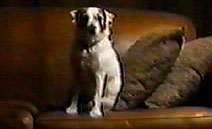|
|
Thread:
Extended
Pilot footage? - (Bob Brooker) |
Related: Interview
with David Lynch - musicolog.com
|
The chronicle behind the film
Initially, "Mulholland Dr." was to mark David Lynch's return to television. It is a retooling of a script originally shot as a 94-minute pilot for a TV series (co-written with TV screenwriter Joyce Eliason) for the channel ABC, which had approved the script, but chose not even to air the pilot once it was done in 1999, despite Lynch's labours to cut the project to their liking. It was left in limbo until 18 month later French company Studio Canal Plus (also producer of 'The Straight Story') agreed to pay ABC $7 million for the pilot, and budget a few million more to turn the pilot into a two-hour, 27-minute movie. The cost of the film doubled to $14 million as sets had to be reconstructed and actors recalled.
Lynch's Picture Factory joined with Imagine Television in association with Touchstone Television to produce a two-hour ABC pilot titled "Mulholland Drive." ABC passed on it for the fall 99 season. The reason was due to the violence in the pilot (the decision came in the wake of the Colorado shootings). With all the political pressure out now for Hollywood to clean things up it seems ABC got scared and passed on it. Lynch told Premiere magazine, "All I know is, I loved making it, ABC hated it, and I don't like the cut I turned in. I agreed with ABC that the longer cut was too slow, but I was forced to butcher it because we had a deadline, and there wasn't time to finesse anything. It lost texture, big scenes, and storylines, and there are 300 tape copies of the bad version circulating around. Lots of people have seen it, which is embarrassing, because they're bad-quality tapes, too. I don't want to think about it."
Creative differences
The day after receiving the script, Jamie Tarses and Stu Bloomberg, who is co-chairman of ABC Entertainment Television Group, called Tony Krantz to green-light production. "They were giddy with excitement," Krantz recalls. Steve Tao said, "It's one of the fastest scripts we've ever read – we could see it." ABC would eventually order pilots for seven dramatic series for the fall season, and the network expected to find room on its schedule for three or four. "Mulholland Drive" looked to be a shoo-in.
But the executives did wonder how the seemingly unconnected scenes and characters would be tied together. Lynch's scripts, dense with dream images, don't gather up loose ends and sweep to a close; instead, they jump around and then break off, as if jarred by an alarm clock. Although this strangeness was a selling point, it was also a cause for concern. "There's a very fine balance between intriguing people and confusing people," Steve Tao said.
And so, two weeks after ordering the pilot episode, Bloomberg and Tarses summoned about twenty people from the network, Imagine, and Lynch's production company to meet in ABC's conference room. At "notes meetings" like this one, networks begin to put their stamp on a show, analyzing everything from the characters' morals to their hair styles. Most executives believe that television shows – unlike movies, which people actively seek out – are watched passively by a tired and fickle audience; and so stories should move quickly and clearly, and characters' problems should engender immediate sympathy. "The secret is to have a character who is very relatable, whom you root for," Jamie Tarses says. "And the rest is how you dress it up."
Steve Tao told me, "David was very collaborative. I had a list of twenty questions. He said, 'I'm not going to answer that, but it's a good question.' Next? 'I'm not going to answer that, but it's a good question.' Next? 'I know that answer, and you're not going to learn it now.' At least I knew he was thinking about our concerns."
Lynch didn't relish the scrutiny, however. "David is willing to attend something like that meeting as a gesture of cooperation," Mary Sweeney says, "but he believes that questions about motivation are not pertinent." Lynch himself says, "A lot of times, I just didn't know what the answer was going to be, and I was covering up so that I wouldn't worry them."
When they turned down the Pilot
Production began in February 1998 on the Paramount Studios lot, and by May 1998, Lynch had completed a 125-minute version of Mulholland Dr. In June 1998, Lynch was notified that ABC would not pick up the pilot and was not interested in producing a series based on Lynch’s story. According to a Sep/Oct 2001 article in Film Comment, the network felt that the pilot was too dark, slow and confusing.
[...] Krantz had heard rumors that ABC would not pick up the pilot, but he still hoped that the network would select the show for midseason, the way it had done with "Twin Peaks." "It's going to be a pass," Tao told him. "I'm sorry." Krantz immediately phoned Lynch. "They don't want it," Krantz said "They don't want it for fall, and they don't want it for spring." "I see," Lynch said. Later, Krantz told me, "I think David was surprised. He's an artist. And when someone tells you, "The thing you love, we don't love; we don't value your inner life' – that's very personal."
When the show's cast and crew learned of its demise, they were outraged. Justin Theroux had turned down a chance to be in "Wasteland" in order to work with Lynch on "Mulholland Drive." Yet he believes that he chose well, because he learned a salutary contempt for how television shows are chosen. "I want to say that the people at ABC are terrible, awful, heinous people who kiss up to you when they think you might be a star and then drop you like a hot turd when they decide you won't be," he said. "But really they're just terribly frightened people who want to keep their jobs by giving audiences what they want. The audience testing that the networks do is in Middle America, and I picture these men and women who spend their time in McDonald's and bent over slot machines being brought into a room in a mall to watch David Lynch and turn up their knobs if they like it. Those knobs are going to be arrow-headed to the ground. On that basis, ABC assumes that America wants 'Wasteland' and not 'Mulholland Drive,' which means that they assume America is stupid. The sad thing is they're probably right."
A few weeks later, I visited Lynch at home, in his woodshop. I asked him how he felt about ABC's rejection. He pushed his index fingers against his lower lip and remained in a brown study for a full two minutes. He rose and hit the intercom to request a cup of coffee, sat and thought for thirty seconds more, and finally said, "At a certain point, you realize you're in with the wrong people. Their thinking process is very foreign to me. They like a fast pace and a linear story, but you want your creations to come out of you, and be distinctive. I feel it's possibly true that there are aliens on earth, and they work in television."
David Lynch on how it turned into a feature
 "So
along came Pierre Edelman (Studio Canal Plus) and Pierre asked me if he could see
this pilot and I had a heartache because I didn't like the pilot and I said no
at first but he asked me again and I said okay Pierre. And he saw something in
the pilot that he really liked. And one thing let to another and the opportunity
arose for it to become a feature. And then I had a couple of weeks a feel of
panic because I didn't have ideas to close it. And one night sitting down in my
chair the ideas unraveled like a string and it came to me a way to do it. And it was a most beautiful experience. Everything was seen from a different angle. Everything was then restructured, and we did additional shooting. Now, looking back, I see that [the film] always wanted to be this way. It just took this strange beginning to cause it to be what it is."
»related
video clip (0.5 MB)
"So
along came Pierre Edelman (Studio Canal Plus) and Pierre asked me if he could see
this pilot and I had a heartache because I didn't like the pilot and I said no
at first but he asked me again and I said okay Pierre. And he saw something in
the pilot that he really liked. And one thing let to another and the opportunity
arose for it to become a feature. And then I had a couple of weeks a feel of
panic because I didn't have ideas to close it. And one night sitting down in my
chair the ideas unraveled like a string and it came to me a way to do it. And it was a most beautiful experience. Everything was seen from a different angle. Everything was then restructured, and we did additional shooting. Now, looking back, I see that [the film] always wanted to be this way. It just took this strange beginning to cause it to be what it is."
»related
video clip (0.5 MB)
"[…] Since this started out to be a television pilot which doesn't have an ending, an ending had to come somehow. And I didn't have any ideas for this ending. And one night, I sat down in a chair, and I closed my eyes, and ideas came. It's all ideas. So, the ideas came, and then I knew what it was. Now, these ideas that came, weren't just for the ending. They were for the beginning and the middle and the end, a whole shifting. Then we went back and shot for several more weeks to finish the film that needed an ending because it was not a TV show anymore. But ideas came one night, from 6:30 to 7:00, in they came." »related video interview
On how the TV-show would have continued
I just remember him [Lynch] saying that it would be a series of mysteries that spun out of each other and would never have a conclusion, unlike 'Twin Peaks'. He was very upset that Laura's killer had to be named and said he would not let that happen again.
Adam and Betty would embark on the affair indicated by the sparks ignited by their first brief meeting. More intriguingly, during the first year of the show the life-paths of two female leads would cross, the noir elements of the plot absorbing Betty as she was sucked into Rita's dark world while the mystery girl herself would find redemption. And, in response to politely insistent queries, Lynch promised that when Rita's identity was finally revealed it would only open up other mysteries.
Weirdsville USA: Obsessive Universe of David Lynch
Laney, the mysterious homeless character (prostitute) would get revealed throughout the series and come to a grande finale when the big secret is unfolded.
In an interview with Chris Rodley Lynch says that MD has become simpler as a movie (as a love story) than it was supposed to become as a series. He is grateful to ABC to have killed the project because it has given him the opportunity to change completely his point of view about the MD story. It is clear that esthetically speaking the love story is so beautiful that the remaining of the story is not necessary. - (gandalf36)
One scene filmed for the pilot but cut from the film was a phone call from Adam to Wilkins asking if he could stay at Wilkin's place for a while. Wilkins lived at Havenhurst so Adam would've been a neighbor to Betty and Rita in the series. - (somethingbad)
Thread: MD-The Series - (psf)
Scene-by-scene comparison of non-aired Pilot (1999) and final Feature (2001)
|
Jitterbug
Contest/ |
Newly shot footage of 2000 |
|
|
Limo ride/ |
Pilot credits are
different in appearance to final version. |
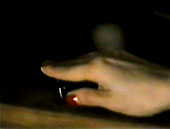
|
|
Detectives |
Pilot: Dialogue is slightly longer. Second detective talks about a blind corner and some witness to the drag racing. |
|
|
Phone Call Chain |
Pilot: We see Mr. Roque using a hand held device (with his right arm) to initiate the call. Decoration at destination changes from blue table (Pilot) to red lamp shade (Feature). On the table sits a sleek modern, ultra-minimalist phone with no receiver. A blue hue/light is on the table making the table appear very blue cubic in theme. A woman's hand with long red nails pushes a button and the phone halts its ringing. |
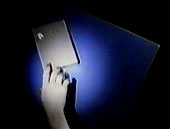 |
|
Aunt Ruth's departure |
Pilot: Aunt Ruth's line "Just one more bag after that." is missing and no wobbling POV shot from behind the trees. |
|
|
Dan & Herb at Winkie's |
This part is missing in the shortened Pilot version. No Dan, no Herb, no Bum. Note: Whilst Dan and Herb's 'Breakfast at Winkie's' scene did not appear in the rough cut pilot, it was a part of the pilot script, so all signs point to this scene being shot in 1999 with the rest of the pilot footage despite it not making it into the pilot film that David presented to ABC. |
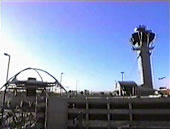
|
|
L.A. Airport |
Pilot: The speakerbox is saying "Attention travelers, you are not required to give money to solicitors. This airport does not sponsor their activities. Thank you." Pilot holds shot of LAX flight command center, but the entire outdoor part is missing. |
|
|
LIMO RIDE OF OLD COUPLE |
Newly shot footage of 2000 |
|
|
BETTY MEETS COCO & RITA AT HAVENHURST |
Pilot: Betty's arrival is shortened, but includes two shots of the poop in the courtyard, whereas the Feature had just one. Pilot: Coco mentions the rooftop garden and Betty plants a big kiss on her cheek ("Oh Coco ah, thank you! Thank you so much!").
Pilot: Betty is shown touching the top of the bureau as she goes
into the bedroom. Pilot: No mentioning about Betty's aunt or her origin Deep River, Ontario; also the line "...and now I' am in this dream place!" is missing. |
|
|
Ryan Board Office |
Pilot includes scenes with Adam arriving before the Castigliane brothers plus the Castigliane brothers leaving before Adam. Feature cuts out the dispute between Adam, his manager and Ray. Adam is shown to be of sinister, arrogant nature - a characteristic inappropriate for the feature's plot development. Pilot: Different look of blond Camilla on headshot. In Feature the headshot is subtitled with "Camilla Rhodes", in Pilot the name is merely affirmed by Vincenzo Castigliane. The Pilot does not have a cut away to see Mr. Roque watching the video feed. Also the Espresso man is seen waiting seconds longer for a gesture by Luigi before leaving the room. After spitting out the espresso, Luigi looks across the table and swears in Italian "Porca miséria!" (miserable pig). In Feature, he utters "shit" off-camera. Luigi's last line "That is the girl." (Pilot) was overdubbed to "This is the girl." (Feature). At the parking lot where Adam smashes the windshield, the Pilot is retinued by metallic blast sounds whereas the Feature has knocking-like sounds. |
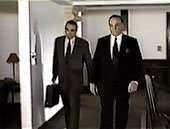 |
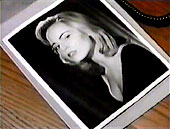 |
||
|
RAY & MR. ROQUE |
The Pilot shows different levels of security that Ray Hott has to go through to see Mr. Roque, including punching in codes and stating his name and code. There is a very short scene with Mr. Roque's personal assistant (played by Julie Dreyfuss) saying "You can go right in, Ray." Ray's speaking part, when talking to Mr. Roque, is somewhat different in Pilot and Feature. In the Pilot he doesn't mention the actress' name (Camilla Rhodes). In combination with the untitled headshot (previous scene) it seems like her name was of minor interest for the pilot. Pilot: The Castigliane Brothers are shown leaving by the same stairs with the same security system that we saw Ray use. Implication is that they had a talk with Mr. Roque beforehand. |
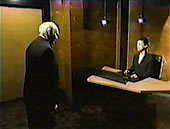 |
|
Joe & Ed in office building |
The Pilot does not have the lines about how times are so tough and how things are going but goes directly into Joe inquiring about Ed's famous black book. Scene missing from Feature: Back in Ed's office the fat lady yells "Get away!" after seeing the gun and Joe has to shove her to the floor a second time. |
|
|
Prostitute at Pink's |
Feature: Loud lip smacking of Joe eating is significantly reduced. Pilot: View lasts longer on blue van, after girl gets a smack on the ass. We see Joe and Billy heading to the front of the van, meaning to drive away. |
|
|
Adam on highway |
Cynthia's voice is re-recorded in Feature for higher clarity. Also her speaking part differs slightly in both versions. |
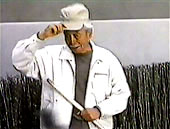 |
|
Adam catching Gene & his wife |
Pilot is underlaid with different, unknown soundtrack.
|
|
|
Betty & Rita at Winkie's |
Pilot: Betty's conversation on the pay phone about the accident on MD is one way, at this point there was no audible policeman on the other end.
Feature: Diane's (the waitress) voice is overdubbed. She says
"okay" when she hears they just want the check. It has a decided
hard edge to it and a look that indicates that she is under some sort of
stress. In the Pilot, the "okay" is quite soft and
non-offensive. |
|
|
Betty & Rita MAKING PHONE CALL |
"Hello, it's me. Leave a message." The pacing of the AM's voice in Pilot is different from Feature and the voice may be different too (likely the neighbor's). Compare samples of Pilot and Feature. |
|
|
Kenny beats up Gene & Lorraine |
Combat in Pilot is harsher: When Kenny pushes Lorraine behind him, there is a larger crash as if she hits the floor or the wall hard/loudly. We also see Lorraine and Gene lying on the floor unconsciously. Pilot shows the kitchen's sink which is overflowing with red running water with the jewelry box floating in one of the full basins. After Kenny is breaking each of Adam's golf clubs in two he walks out saying "He's not here." to the guy with the window down in the back of the limo. Thread: Big visitor to Adam's house - (somethingbad) |
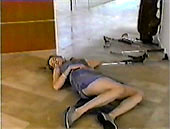 |
|
Park hotel/Phone Call |
Pilot: After Adam's call, Cynthia starts to dial the Cowboy's number. |
|
|
Louise Bonner |
Pilot omits this part. Instead we see Wilkins receiving a phone call from Adam. |
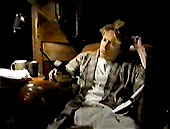
|
|
Adam & Cowboy at corral |
Pilot: Before we see Adam driving up to the corral there is a shot of him leaving the city with the night skyline in the back. The camera pans over to something that looks like a bridge. Exact same location and camera work is used for later cab ride taking Betty and Rita to Club Silencio. The song playing over (Take five) is the same as in the scene with Adam talking to Cynthia in his car. |
|
|
Rehearsal/ |
The Pilot has no courtyard scene with Coco's warning to Betty and her finding Rita in the apartment. Pilot: There is music from "Sunset Boulevard" when cutting to the gates of Paramount Studios. However, the part with Betty coming in by cab and Wally introducing his crew is missing. Also, the audition concludes earlier in Pilot. Betty says "well, there it was" and then fade to black (no goodbyes or congratulations). |
|
|
Sierra Bonita |
The Pilot is missing some shots:
Feature: The sound of the neighbor opening her door as well as the phone ring are different. Also her launching "Yes?" is an overdub. In Pilot it sounds more strident. Pilot includes the shot of a painting within #17. Rita stares at it and Betty asks "Do you remember something?". Then there is another shot of a stairway leading up to the roof. Neighbor knocking on the door is much louder in the Feature and more knocks are heard. |
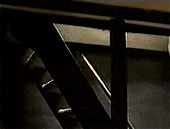
|
|
Making over |
Leaning over the sink we hear Rita sobbing: "What I HAVE to DO." Her weeping is more prominent in Pilot, partly muted in Feature. Betty saying "SO, let me do it." changes to "BUT, let me do it." in Feature. |
|
|
Pilot Ending |
After the mirror scene the Pilot version concludes. Final sequence:
Note that this was the first (and only) scene with the bum in the Pilot as the part with Herb and Dan at Winkie's was omitted. |
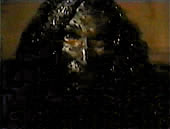
|
|
Betty & Rita in Bed |
Feature footage of 2000 |
|
|
CAB RIDe/CLUB SILENCIO/ RETURN TO HAVENHURST |
The nocturnal cab ride and surrealistic Silencio finale was shot in late 1999 as a closed ending for a theatrical release of the Pilot for the European market. The American TV Pilot, however, doesn't include this extra material. |
|
|
DIANE
Waking up/ |
Wrap-up with newly shot scenes of 2000 for the cinematic version carries on to the end of the movie. |
|
|
- END – |
||
